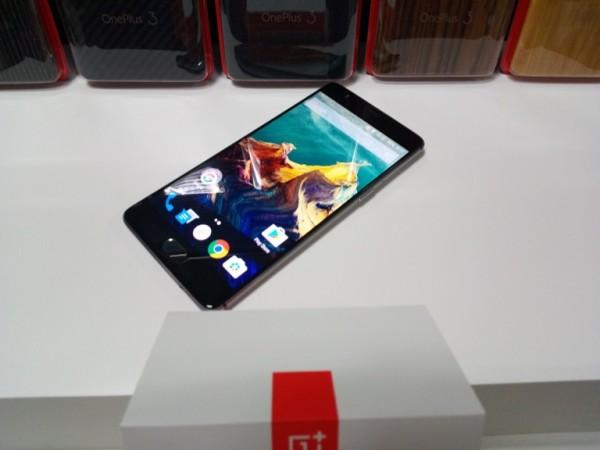
OnePlus has surely made heads turn with its latest and biggest flagship release of this year, OnePlus 3, in India and other parts of the world on June 14. The company's flagship killer title, which was coined for the original OnePlus One smartphone, finally suits the OnePlus 3 as it goes head-on against the industry's biggest and most popular flagships.
When the OnePlus 3 was launched last month, we were quite impressed by the strong spec sheet. Then we received the review unit of the OnePlus 3 within few days of launch and we have since been testing the device and its various features. After using it for almost a month now, we are finally ready with our review of the OnePlus 3 and a verdict whether it is a safe investment for smartphone enthusiasts.
OnePlus 3 is priced at Rs. 27,999 and competes alongside handsets like Xiaomi Mi 5 and LeEco Le Max 2, but also gives Samsung, Apple, Sony and LG a good run for their money. We briefly compared the camera of the OnePlus 3 against the Galaxy S7 Edge and iPhone 6 and found it surprisingly better than both flagships.
Before getting started with the review, take a look at the specifications that OnePlus 3 offers:
Display: 5.5-inch Full HD Optic AMOLED display, Corning Gorilla Glass 4 shield
Camera: 16MP rear camera and an 8MP front snapper
Processor: Snapdragon 820 CPU
RAM: 6GB DDR4
Storage 64GB
Battery: 3,000mAh with Dash Charge (5V 4A)
OS: Android 6.0.1 Marshmallow-based Oxygen OS
Add-ons: Metallic unibody, fingerprint scanner, dual SIM, USB Type-C, NFC, Dirac HD Sound, dual-microphone with noise cancellation
Dimensions: 152.7x74.7x7.35 mm
Weight: 158 grams
During our month-long review, we noticed some interesting features that make OnePlus 3 an outstanding device but it is not devoid of flaws.
OnePlus 3's pros outweigh the cons.
Design
OnePlus has really worked on the design of the OnePlus 3 smartphone. The 2016 flagship spells class in every way, especially the rear design. OnePlus 3 is available only in grey colour, which complements the design of the rear panel. The slightly shimmering metal panel at the back houses the camera module, LED flash and the company's logo at the center. There are two horizontal antenna lines at the back.
At first glance, the rear panel looks flat. But when you look closely, there is a slight curve, which the company claims to have achieved over a span of 3-4 months.
The level of perfection in OnePlus 3's design is commendable.
The rear camera protrudes from the rear panel, but when we are using a back cover, it fits precisely in one plain. The curve ends towards the sides of the device, giving an ultra-slim profile, which is quite comfortable to hold. The rounded corners add to the grip, making it suitable for one-handed operations despite a large screen.
On the sides, we find the power/lock button on the right and the volume rocker buttons and alert slider on the left. The front portion of the OnePlus 3 is completely black, which makes it hard to differentiate the display from the upper and lower bars.
There is a physical home button at the bottom of the display, but it only works as a capacitive touch. The home button also has a fingerprint scanner integrated within. The speaker, sensor and the front camera are all placed at the top and the bezels are extremely slim.
Overall, OnePlus's design is a true work-of-art, and not a rip off of the popular phones.
Display
When we heard OnePlus 3 has a Full HD display, there was a sense of disappointment, but there isn't really any need for a higher resolution screen unless you are into virtual reality or gaming. For regular use, a Full HD 1080p display does the job fairly well. OnePlus 3 has a 5.5-inch Full HD screen with Optic AMOLED panel.
OnePlus 3's display is better than most Full HD screens we have reviewed. The colours are vibrant, rich and clear. The touch interface is smooth and works without issues even around the corners.
OnePlus 3's Full HD display will not make you miss a 2K screen
Camera
OnePlus 3 features an impressive 16-megapixel rear-facing camera with Sony IMX 298 sensor, which has an aperture of f/2.0, along with premium photo enhancing features of OIS, EIS, PDAF and 4K video recording. On the front, it has an equally impressive 8MP Sony IM179 sensor with f/2.0 aperture for great selfies.
As capable as the camera configuration looks on the OnePlus 3, the results shot using the review unit were compelling and rich with details. We tested the camera in broad daylight and low light conditions, only to witness great quality results. The front camera is also great for selfies and delivers more than users' expectations.
OnePlus 3's camera outperforms most flagships in the current market.
We are sharing a few photos shot using the OnePlus 3 camera below so you can be the judge:
While most users might settle for the standard video recording, OnePlus 3's 4K recording can be used by professionals. Shooting for long videos in 4K heated the device to an average point, but short videos did not create any hiccups.
The UI of the camera is quite simple with all the options in the front and center. The selfie camera activates automatically with a timer, which makes it easy for users. But the timer gets activated even when we were trying to switch the cameras, so we had to manually pause the timer every time.
Performance
We were quite keen on testing the OnePlus 3's performance, mainly because it is one of the few devices in the market with 6GB RAM. There were reports about the device not utilizing the full RAM capacity, to which the company's founder Carl Pei responded with an explanation. OnePlus rolled out an OTA update to enable eRGB mode in developer options as promised and also improved RAM management.
Nevertheless, OnePlus 3 did not fall short of delivering anything less than what was expected of it. After all it is powered by a Qualcomm Snapdragon 820 chipset, which is known to drive great results.
Multi-tasking in OnePlus 3 was seamless, intense gaming was lag-free and OnePlus 3 excelled in overall performance.
Launching apps even after closing them from the background did not cause any delay. We played games like 8-Ball Pool, Asphalt and Mini Militia and found the device to handle them very well. The graphics were great and we have no complaints with the device's performance. We witnessed some glitches in the OS at some instances, but after updating the device's software via OTA seems to have addressed them all.
We ran some tests on prominent benchmarking apps such as AnTuTu and Geekbench and the results were terrific.
OnePlus 3 also runs the latest Android 6.0.1 Marshmallow with its own Oxygen OS on top of it. The experience isn't too different from stock Android, but there are certain customizations like changing the colours of the settings menu. There were no lags in the UI as well, which is a good thing.
OnePlus 3 never seized to impress, but the lack of a microSD card slot is a major turn off in the device. The limited 64GB storage can be suffice but a microSD card slot (at least a hybrid one) could do wonders.
Battery
With OnePlus 3, the company introduced its own fast charging tech called Dash Charge, which is one of the major highlights of the device. The flagship is powered by a 3,000mAh battery. Dash Charge technology (5V 4A) charges the device pretty quick and that was one of the fastest we have seen in devices that support the technology.
During our review, OnePlus 3 charged from zero to 70 in little over 30 minutes but took up to an hour for 100 percent. If the user is travelling and there is no means of charging, the power saving mode comes in handy, which can be activated anytime. The device's performance and animations are reduced to extend the battery in this particular power saving mode, as is the case with most devices with the feature.
OnePlus 3's Dash Charge is a boon.
As for the battery life, we used the device for almost two days without using internet and just relying on calls and messaging. With the 3G/4G data active at all times, the device lasted up to 10 hours, which is still commendable. But if you activate power saving mode, expect an additional 2 hours extra life.
OnePlus also sent us the car charger for the OnePlus 3, which is Dash enabled. We tested it and it works wonders. Usually, it is a pain to charge smartphones in car as it takes longer than usual, but OnePlus' car charger is the key.
Note: The OnePlus car charger isn't part of the OnePlus 3 package and so aren't the back covers pictured below.
Fingerprint scanner
Since the budget smartphones are also coming with fingerprint scanners, it is obvious OnePlus 3 to have the biometric sensor. The performance of that feature, however, differs from device to device. OnePlus 3's fingerprint scanner is accurate and snappy. Simply placing the finger on the home button unlocks the device within a blink of an eye.
On the downside, the fingerprint sensor is always active to any touch. For instance, if you are simply holding the device in your hand and if you touch the home button, there is a mild vibration to alert a wrong fingerprint attempted to unlock the device. If the user tries to take out the phone from the pocket by placing the registered finger on the home button, it will instantly unlock the device.
Audio
OnePlus 3 doesn't come with a pair of earphones, but we tested with our own. We were curious to test LeEco's CDLA headphones that can connect to USB Type-C port in the OnePlus 3 and the quality of the sound was absolutely stunning. Better your earphones, better the quality of the sound on OnePlus 3.
Combine OnePlus 3 with USB Type-C headphones to disconnect from the world into your favourite tracks.
As for the stereo, the sound is clear in closed rooms and halls. The single speaker is placed at the bottom next the charging point, which makes it audible without any blockade. But if you are riding and the phone is on loud, rely on the vibrator for your calls and messages notifications. Even the vibrate intensity isn't too great, which may result in missing a few calls while riding in bikes or in noisy market areas.
Conclusion
As we noted, OnePlus 3's pros are outweighing the cons, but it is worth mentioning where the handset misses the mark. Firstly, the handset is hit by connectivity issues, making it difficult to establish consistent Wi-Fi or Bluetooth connections. Another important miss is that OnePlus 3's fast charging works only with the company-issued Dash charger. When using a standard USB Type-C charger, an obvious delay can be expected. Finally, OnePlus still doesn't come with earphones. Since it works greatly with USB Type-C headphones, it would make sense for the company to throw in a pair of free headphones with the box, even if it is a 3.5mm earphone. Buyers are after all spending almost Rs. 30,000 for this device.
If we can put this behind, OnePlus 3 will not leave its owners unsatisfied. The camera is excellent, the Dash Charge works great, design is mesmerizing, performance is phenomenal and the fingerprint scanner is perfect. OnePlus 3 is easily a device that can change your mind about obnoxiously priced flagships.
To sum it up, OnePlus 3 is future ready and built to last.















